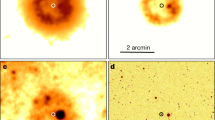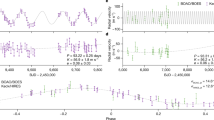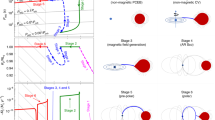Abstract
It has been suggested that the tidal capture of a red giant by a neutron star in globular clusters may result in bound systems1, the subsequent evolution of which may lead to a variety of interesting objects, including millisecond pulsars2,3. But, the binding energy of the envelope of a giant is much less than that of a main-sequence star4, so the ratio xcrit = Rcrit/R*(where Rcrit is the maximum distance of closest approach between two stars for which the tidal energy is sufficient to bind the system, and R* is the radius of the star on which tides are being raised) will be less for giants than for main-sequence stars. Here I present a simple expression for the amount by which xcrit is diminished as a star evolves, and conclude that tidal capture of giants by neutron stars resulting in binary systems is unlikely in globular clusters. However, collisions between neutron stars and red giants3,5,6, or an alternative process involving tidal capture of a main-sequence star into an initially detached binary system7, may result either in rapidly rotating neutron stars or in white dwarf/neutron star binaries.
This is a preview of subscription content, access via your institution
Access options
Subscribe to this journal
Receive 51 print issues and online access
$199.00 per year
only $3.90 per issue
Buy this article
- Purchase on Springer Link
- Instant access to full article PDF
Prices may be subject to local taxes which are calculated during checkout
Similar content being viewed by others
References
Verbunt, F. & Hut, P. in IAU Symp. 125 (eds Helfand, D. J. & Huang, J. H.) 187–196 (Reidel, Boston, 1987).
Romani, R. W., Kulkarni, S. R. & Blandford, R. D Nature 329, 309–310 (1987).
Verbunt, F., van den Heuvel, E. P. J., van Paradijs, J. & Rappaport, S. A. Nature 329, 312–314 (1987).
Ostriker, J. P., in IAU Symp. 113 (eds Goodman, J. & Hut, P.) 358 (Reidel, Boston, 1985).
Suntanyo, W. Astr. Astrophys. 44, 227–230 (1975).
Verbunt, F. Astrophys. J. 312, L23–L25 (1987).
Bailyn, C. D. & Grindlay, J. E. Astrophys. J. 316, L25–L29 (1987).
Fabian, A., Pringle, J. & Rees, M. J. Mon. Not. R. Astr. Soc. 172, P15–P18 (1975).
Press, W. H. & Teukolsky, S. A. Astrophys. J. 213, 183–192 (1977).
Lee, H. M. & Ostriker, J. P. Astrophys. J. 310, 176–188 (1986).
McMillan, S. L. W., McDermott, P. N. & Taam, R. E. Astrophys. J. 318, 261–277 (1987).
Mengel, J. G., Sweigart, A. V., Demarque, P. & Gross, P. G. Astrophys. J. Suppl. ser. 40, 733–791 (1979).
Sweigart, A. V. & Gross, P. G. Astrophys. J. Suppl. ser. 36, 405–437 (1978).
Bodenheimer, P. & Taam, R. E. in NATO Conf: Evolution of Galactic X-ray Binaries (eds Trumper, J., Lewin, W. H. G. & Brinkmann, W.) 13–24 (NATO ASI Series, 1986).
Stella, L., Priedhorsky, W. & White, N. E. Astrophys. J. 312, L17–22 (1987).
Bonsema, P. T. J. & van den Heuvel, E. P. J. Astr. Astrophys. 146, L3–L4 (1984).
Author information
Authors and Affiliations
Rights and permissions
About this article
Cite this article
Bailyn, C. Neutron star/red giant encounters in globular clusters. Nature 332, 330–332 (1988). https://doi.org/10.1038/332330a0
Received:
Accepted:
Issue Date:
DOI: https://doi.org/10.1038/332330a0
This article is cited by
-
Old pulsars in the low-density globular clusters MI3 and M53
Nature (1991)
-
Birth of millisecond pulsars in globular clusters
Nature (1988)
Comments
By submitting a comment you agree to abide by our Terms and Community Guidelines. If you find something abusive or that does not comply with our terms or guidelines please flag it as inappropriate.



